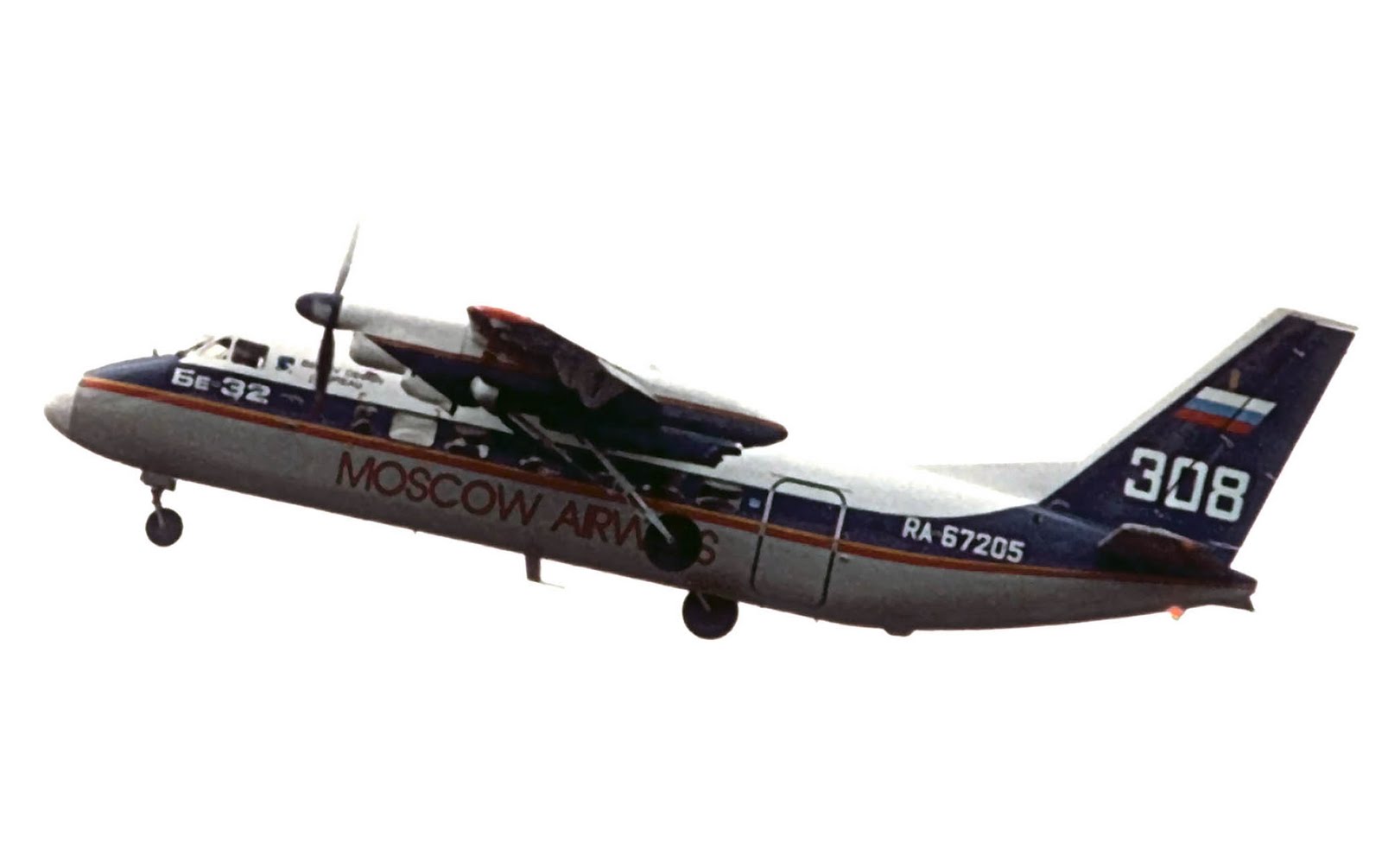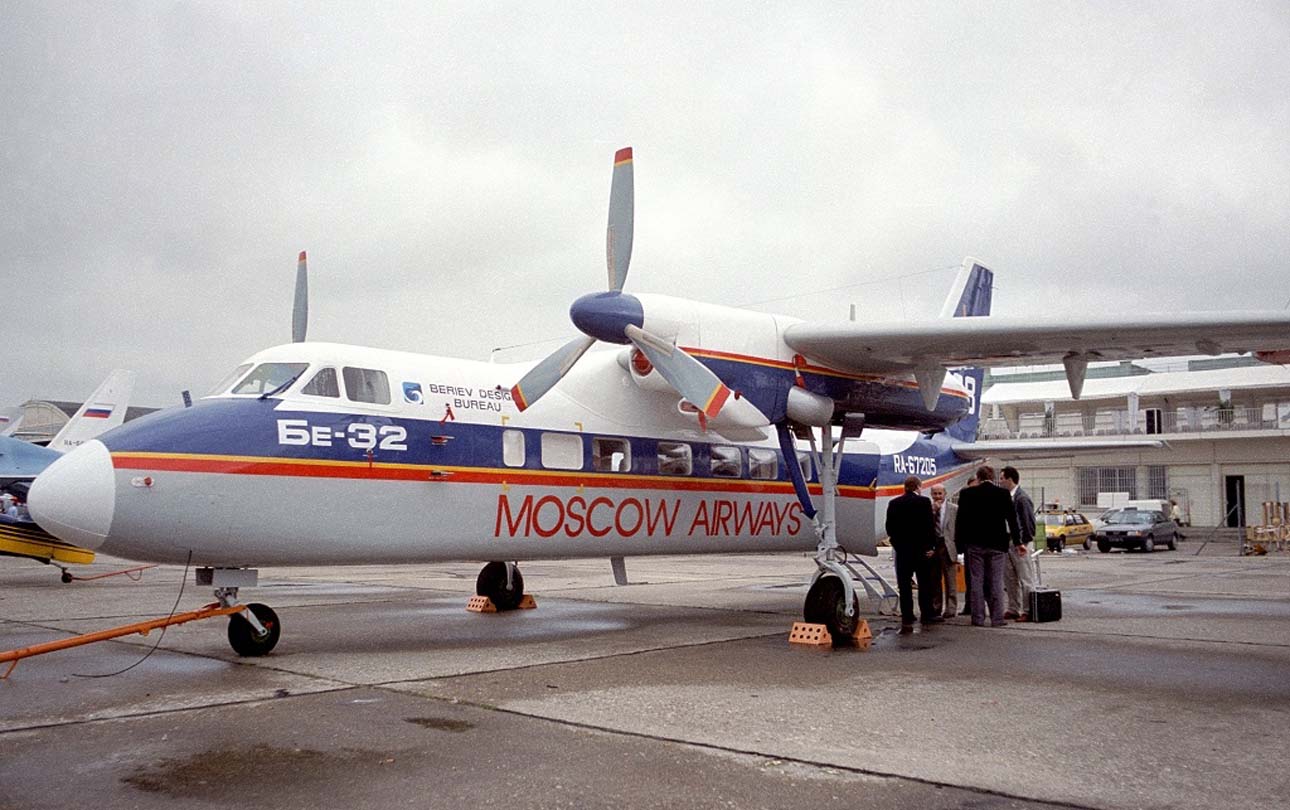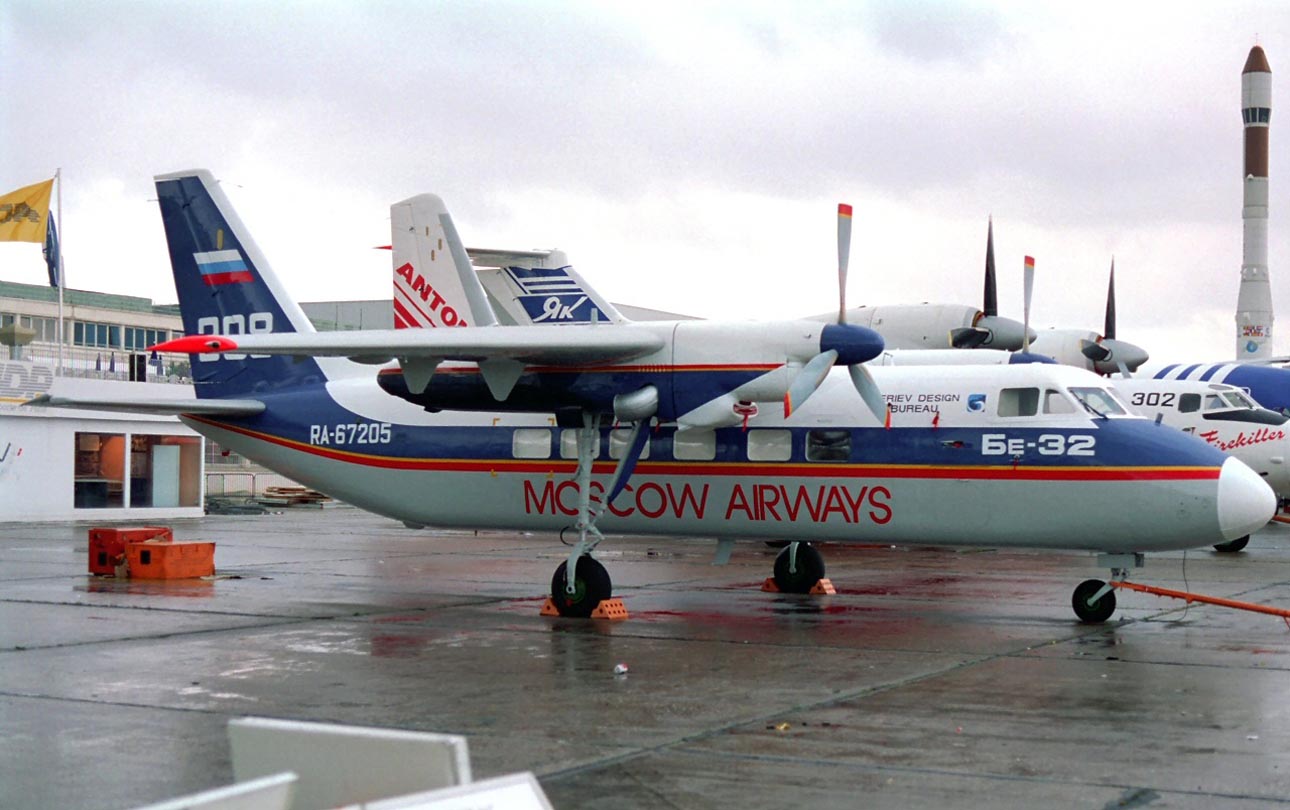
Beriev Be-30/32
- CountryRussia
- TypeRegional airliner and utility transport
- PowerplantsBe-30 - Two 708kW (950shp) Glushenkov TVD-10 turboprops, driving three blade constant speed propellers. Fuel capacity 1000kg (2204lb). Be-32 - Two 754kW (1011shp) Glushenkov (Omsk) TVD-10B turboprops driving three blade constant speed propellers. Be-32K - Two 820kW (1100shp) Pratt & Whitney PT6A-65B turboprops driving three blade Hartzell reversible pitch propellers. Fuel capacity 2250ltr (594USg)
- PerformanceBe-30 - Max cruising speed at 2000m (6500ft) 480km/h (259kt), economical cruising speed at 2000m (6500ft) 460km/h (248kt). Range with max payload, no reserves, 400km (215nm), with max fuel, payload 900kg (1980lb), no reserves, 1300km (700nm). Take-off run 250m (820ft). Landing run 130m (425ft). Be-32 - Max cruising speed at 3000m (9840ft) 440km/h (237kt), economical cruising speed at 3000m (9840ft) 375km/h (202kt). Max rate of climb at SL with 15deg flaps 1475ft/min (450m). Range with 17 passengers 600km (325nm), with 7 passengers 1750km (945nm). Take-off to 35ft (10.7m) 600m (1970ft). Landing from 50ft (15m) 620m (2035ft). Be-32K - Max cruising speed at 3000m (9840ft) 510km/h (275kt), economical cruising speed at 3000m (9840ft) 370km/h (202kt). Service ceiling 13,780ft (4200m). Range with 30min reserves, 16 passengers, max cruising speed, 600km (325nm), economical cruising speed, 885km (475nm), with 6 passengers, economical cruising speed, 2050km (1105nm). Take-off to 35ft (10.7m) 480m (1575ft). Landing from 50ft (15m) 500m (1640ft). Landing run 240m (790ft).
- WeightsBe-30 - Max takeoff 5860kg (12,920lb), max payload 1500kg (3300lb). Be-32 - Empty 4760kg (10,495lb), max takeoff 7300kg (16,090lb), max payload 1900kg (4190lb). Be-32K - Max takeoff 7300kg (16,090lb).
- DimentionsAll versions - Wing span 17.00m (55ft 9in), length 15.70m (51ft 6in), height 5.52m (18ft 2in). Wing area 32.0m2 (344.45sq ft). Wheel track 5.20m. (17ft).
- CapacityFlightcrew of two. Typical passenger arrangements for 14 (Be-30) to max 17 (Be-32) at two abreast. Corporate shuttle configuration seats seven. Ambulance configuration can accommodate nine stretcher patients, six seated patients and one medical attendant. Baggage hold volume Be-30 forward 0.3 + 0.3m3 (10.6 + 10.6cuft), aft 1.6m3 (56.5cuft), Be-32 1.33m3 (47cuft).
- Production3 Be-30s and 5 Be-32s were built in the late 1960s before program terminated. One of the original Be-32s was converted to Be-32K demonstrator.
The Beriev Be-32 is an overhauled improvement of the Be-30 worker that was initially created for Aeroflot in the late 1960s.
The Beriev Be-30 was outlined against an Aeroflot prerequisite for a twin turboprop aerial shuttle and utility transport in the late 1960s as a trade for the Antonov A 2 on low thickness courses, or where landing strips were deficient for bigger air ship.
The model Be-30 first flew on March 3 1967, briefly controlled by two 550kw (740hp) Ash-21 cylinder outspread motors. These motors were supplanted by 723kw (970shp) TVD-10 turboprops, with which the first flight was made on July 13 that year. The model was shown statically at the Domodedovo flying demonstration in July 1967. Two different models were likewise assembled. The Be-30 had accomodation for 14 travelers. The airplane was further formed into the Be-32, which had higher fueled TVD-10b motors, and accomodation for up to 17 travelers. It is accounted for that eight generation flying machine were made, somewhere around 1968 and 1976, three at the exploratory manufacturing plant No.49, and five at the Taganrog industrial facility No.86. It is thought however that the initial three are the model Be-30s, and the following five the (pre)production Be-32s. The plane was completely tried in numerous diverse districts in Russia under different working conditions. In the mid seventies Beriev utilized the Be-32 to claim two time-to-stature records (3000m in 2min 24.8sec, 6000m in 5min 18sec). NATO doled out the code name Cuff to the Be-30/32.
The Be-30 needed to rival the Antonov A 28 (first flight September 1969) for the expansive Aeroflot requests that were not out of the ordinary. The Be-30 had a more drawn out reach, was quicker, and would be advised to crosswind taking care of. The A 28 would be advised to arriving and take-off execution and a bigger limit. In this way both flying machine were suggested for generation. In any case the entire venture was scratched off around 1972 when Aeroflot picked the Czech Let L-410 Turbolet (depicted independently) in inclination to Beriev's (and Antonov's) outline. The L-410 had a somewhat bigger burden limit, however was principally picked for political reasons, fortifying the efficient ties with the East European nations. From that point forward the Be-30/32 lay torpid until Beriev restored it in the early 1990s in an offer to draw in new business. As Czech and other remote flying machine and extra parts had now to be paid in hard cash, it was imagined that household airplane could be favored for the inside Russian market, and could increase hard coin when sent out.
Beriev displayed the Be-32 at the 1993 Paris and Dubai aviation expos, the configuration department guaranteeing that the Be-32 joined various enhancements, including all the more influential motors. This demonstrator was one of the first air ship inherent the early seventies. This Be-32 was painted in the shades of Moscow Airways, who had submitted a request for 50 prior in 1993, yet this organization stopped operations before any were conveyed.
Specialized peculiarities of this high wing unpressurised worker incorporate a fuselage of all-metal semi-monocoque structure secured fundamentally with expansive artificially processed boards joined by holding and spot-welding. The cantilever wing has anhedral on the external boards. The competes of the primary torsion box and the skin boards are made of mechanically and artificially processed profile pressings. The separable heading edge is of fortified development. Flimsy 3-layer honeycomb boards solidified by stringers are utilized for about a large portion of the wing skin. Holding and spot-welding is utilized for the greater part of the joints. Twofold opened folds possess the trailing edge inboard of the ailerons.
The tail unit has a comparative all-metal cantilever structure with a slender honeycomb skin coating. For weight sparing, glass fiber strengthened plastics are utilized for some non-load-convey parts, for example, the wingtips, some tail surfaces, and wing/fuselage filets.
A hot-air de-icing framework utilizing motor drain air is accommodated the wings, tail unit, and motor air admissions, while the windscreen and propellers have electric de-icing. The flying machine has a retractable tricycle arriving apparatus with a solitary wheel with a low weight tire on every unit. The fundamental units withdraw rearward into the motor nacelles. The nosewheel withdraws forward and is steerable. Buoys and skis are discretionary. There is procurement for an interconnecting shaft between the motors that allows control on both propellers amid a motor out condition. This framework was introduced and flight tried on the second model. There are four basic fuel tanks, placed in the wing torsion box.
The Be-30 has accomodation for a group of two on the flight deck and 14 travelers in the lodge, later expanded to 17 in the Be-32. There are two little compartments, for mail and little cargo, on the port side between the flight deck and the lodge. On the starboard side, behind of the lodge, is a little stuff compartment, and a can is given at the back of the lodge. The airplane conveys it collapsing stairway.
On August 15, 1995, a model was flown of the Pratt & Whitney Pt6a-65b controlled Be-32k, a transformation of the Be-32 shown at Paris and Dubai in 1993. Creation air ship will be fueled by the Russian assembled adaptation of this effective motor, the Klimov Pk6a-65b.
In September 1996 it was published that the Be-32 would be created by IAR in Romania, yet these arrangements were later denied. In 1998 it was expressed that the Be-32k would be assembled by Taganrog Aviation, yet flight testing was supposedly still under route in 1999. Clearly there has not been much advancement lately, and the extent that is known, no new airplane have been fabricated since the mid seventies.



